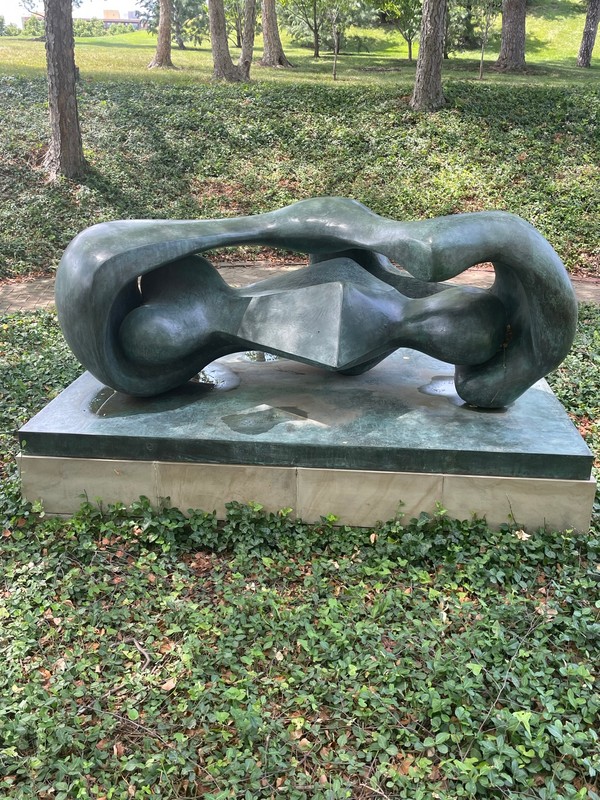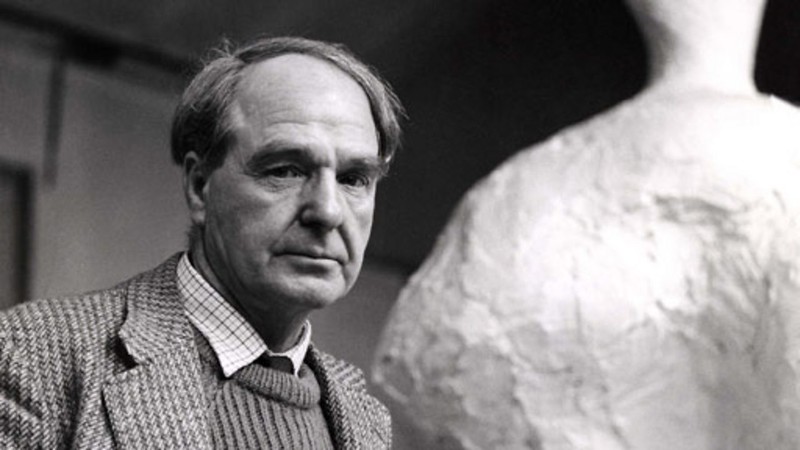Reclining Connected Forms
Introduction
Text-to-speech Audio
Best known for his abstract variations of Reclining Figure, English artist Henry Moore created this bronze sculpture in 1969. The sixth in an edition of nine, Reclining Connected Forms offers a balance of positive and negative space as the outer form embraces the interior form. The work is reminiscent of his signature motif of mother and child, though the title lends the piece to a variety of interpretations. During the time this piece was concepted, Moore was experimenting with the placement of openings, allowing viewers to experience the pieces from multiple angles while also letting light cast through. Working in a variety of mediums, Moore created more than 1,000 sculptures throughout his career, as well as a multitude of drawings and other graphics. Reclining Connected Forms was gifted from the Hall Family Foundation and is one of many Henry Moore sculptures at the Nelson-Atkins Museum of Art.
Images
Reclining Connected Forms by Henry Moore at the Nelson-Atkins Museum of Art, Kansas City, Missouri

English artist Henry Moore

Backstory and Context
Text-to-speech Audio
English artist Henry Moore (1898-1986) was a pioneer for Modernism in sculpture and is one of the most recognized British sculptors of the twentieth century, best known for his abstract figures and Shelter Drawings. Moore showed a talent for drawing early on and at age 11 decided he wanted to become a sculptor after learning about Michelangelo. He served in the British Army in World War I and after the Armistice, received an ex-servicemen grant, then quickly enrolling in the Leeds School of Art. There, he completed a two-year drawing program in one year before transferring to the prestigious Royal College of Art in London where he studied sculpture. He was the only full time student in his program.
Moore developed an abstract style of sculpting early on, often using the female form which was inspired by the sense of stability and protection of his mother. He rented his first studio space in 1924 and with advice from his parents, accepted a teaching position at Royal College. He showed in his first solo exhibition in 1928 which featured 42 sculptures and 51 drawings, and received his first public commission the same year. He began gaining a reputation as an Avant-garde, however, there were conflicting opinions of his unconventional aesthetic. In 1931, after receiving vicious criticism about teaching these new methods, he resigned from Royal College and became Head of the new Sculpture Department at Chelsea School of Art, until 1939.
With the onset of the war, in 1940 Moore moved from London to Perry Green, Hertfordshire with his wife Irina, where they rented half of a rural farmhouse called Hoglands. Soon after, Moore sold a sculpture called Reclining Figure (1939) which earned enough money to buy the property outright, remaining there for the rest of their lives. Varying forms of Reclining Figure would go on to be one of Moore’s most notable forms. He converted the outbuildings at Hoglands into art studios but the war limited supplies for sculpting, so he started drawing again. Often traveling back to the city using the London Underground rail system, Moore was moved by the huddling crowds sheltering in the tunnels from air raids during The Blitz - their resting silhouettes and intimate protection for one another were reminiscent of his previous work. He was then recruited as an official war artist and produced a commiserating series of drawings which would become one of his most superlative accomplishments, known as Shelter Drawings.
After the war, Moore returned to sculpture. He started exploring the relationship between the human form and nature, inspired by the rolling landscape surrounding Hoglands. His daughter was born in 1946, which reignited the mother-child theme in his work. That same year was his first international retrospective and in 1948, he won the International Sculpture Prize at the 24th Venice Biennial for representing the optimistic, humanist values embodied in modernism.
“Of course an artist uses experiences he's had in life. Such an experience in my life was the birth of my daughter Mary, which re-invoked in my sculpture my Mother and Child theme. A new experience can bring to the surface something deep in one's mind.”
The following decades brought international success with multiple commissions, exhibitions, and retrospectives. Throughout his six decade career, Moore created nearly 5,500 drawings, 700 graphics, and more than 1,000 sculptures in a variety of mediums. His legacy is carried on in museums and public spaces around the globe, and through the work of the Henry Moore Foundation, established by Moore in 1977.
Sources
Reclining Connected Forms, The Nelson-Atkins Museum of Art. Accessed August 31st, 2022. https://art.nelson-atkins.org/objects/28637/reclining-connected-forms.
Henry Moore - Reclining Connected Forms, Sotheby's. Accessed August 31st, 2022. https://www.sothebys.com/en/buy/auction/2020/contemporary-art-evening-auction/henry-moore-reclining-connected-forms.
Henry Moore's Legacy, Henry Moore Foundation. Accessed August 31st, 2022. https://www.henry-moore.org/about-henry-moore/henry-moores-legacy.
Learn about Henry Moore, Henry Moore Foundation. Accessed August 31st, 2022. https://www.henry-moore.org/learning-and-engagement/learn-about-henry-moore.
Photo by David Trowbridge
https://www.bbc.co.uk/archive/henry-moore/znkkf4j
